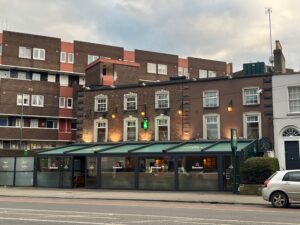 A proper ‘Pubs of Croke Park’ roundup is long overdue, and with so many events on this summer, we may as well finally start working on that. While we’ve already covered a few handy ones like Gill’s Corner House and Juno, it’s time to really start chipping away at the full list, so that all those Oasis fans know where to find their (cigarettes and) alcohol in the area.
A proper ‘Pubs of Croke Park’ roundup is long overdue, and with so many events on this summer, we may as well finally start working on that. While we’ve already covered a few handy ones like Gill’s Corner House and Juno, it’s time to really start chipping away at the full list, so that all those Oasis fans know where to find their (cigarettes and) alcohol in the area.
Although it’s obvious to those of us who live nearby (we have a handy mailing list alerting us of fixtures, crowds and even free tickets at times), it’s worth emphasizing for the out-of-town visitor that all of these pubs are absolutely slammed before big events, whether it’s a concert or big GAA game, so it can be well worth booking in advance and walking a little further to the stadium itself – or, failing that, simply starting early. The game-day or pre-concert experience is quite a different beast to what you’ll find on a quiet Sunday afternoon, but having said that, each pub in the area still has very much its own personality. This week, we’re looking at Phil Ryan’s The Hogan Stand.
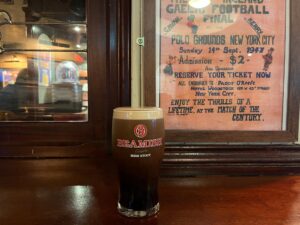
Like its near neighbour Gill’s Corner House, this pub occupies the ground floors of a few Georgian terraced houses, and the front has been enclosed as a covered beer garden, which can be a bit smoky. Inside, it’s very much a classic inner-city pub – a mix of dark wood, table and chairs and a fair few televisions. There’s no craft beer here – even Beamish has only been back on tap since late in 2024 – but there is great value (by Dublin standards): that Beamish is only a fiver. Again, that may be a different experience on big event days, but on a chill afternoon, it’s a welcome treat. Otherwise, there’s your standard Guinness/Heineken lineup, again with some Tuborg in the mix, and both 0.0 options for the flagship beers.
 It’s very much a ‘locals’ pub most of the time, but a welcoming one; I’ve had out-of-town guests wind up there and have great chats with the barstaff. No frills, but no pretention, either. If you are looking to pre-game before an event at Croke Park, it’s hard to be better-placed for an easy walk in to the stadium. And, of course, the pub’s name couldn’t be more appropriate for a stopping-off point before going in to Croke Park itself – a fine way to get into the atmosphere.
It’s very much a ‘locals’ pub most of the time, but a welcoming one; I’ve had out-of-town guests wind up there and have great chats with the barstaff. No frills, but no pretention, either. If you are looking to pre-game before an event at Croke Park, it’s hard to be better-placed for an easy walk in to the stadium. And, of course, the pub’s name couldn’t be more appropriate for a stopping-off point before going in to Croke Park itself – a fine way to get into the atmosphere.
Where: 514 North Circular Road, Dublin 1, Dublin, IE D01 CF57
Access from the city centre: Buses 1, 13, 14, 15, 16, 40, 122, 123; 30ish minute walk
Food: Crisps, peanuts and scampi fries
Sport: Rugby, GAA, football, horse racing…
TVs: Plenty about the place
Music: Some live music events; keep an eye on the socials
Family-friendliness: Always seem to see a few running around
Pub-crawl-ability: Medium – the closest pubs to Croke Park include Gill’s Corner House, The Hideout House, Clonliffe House, Juno, McGrath's, or wander further into Drumcondra toward Fagan's or The Cat & Cage…or walk further still (all along the banks of…) the Royal Canal toward Phibsborough…
Local sites of note: Croke Park, Mountjoy Square
Haunted: We need more ghost stories in this part of town to be shared
Other notes: Main-floor toilets
Socials: Instagram, Facebook

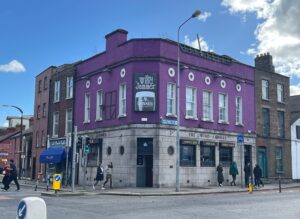 Locals know this, but the visitor to Dublin may not know that horse racing is Kind of a Big Deal. There are endless ads from the various wagering platforms leading up to some of the larger race meetings, and as we’re in the middle of Cheltenham Week*, it seemed appropriate to venture to one of the many Old Man Pubs that draw in the
Locals know this, but the visitor to Dublin may not know that horse racing is Kind of a Big Deal. There are endless ads from the various wagering platforms leading up to some of the larger race meetings, and as we’re in the middle of Cheltenham Week*, it seemed appropriate to venture to one of the many Old Man Pubs that draw in the 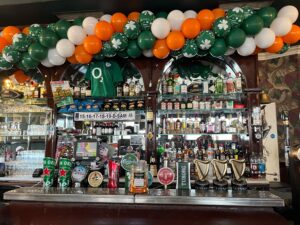 But back to The Wind Jammer: the exterior looks more than a little tired, but once in the door, it’s perhaps surprisingly tidy and well-wallpapered – not to the standard of the much-newer
But back to The Wind Jammer: the exterior looks more than a little tired, but once in the door, it’s perhaps surprisingly tidy and well-wallpapered – not to the standard of the much-newer 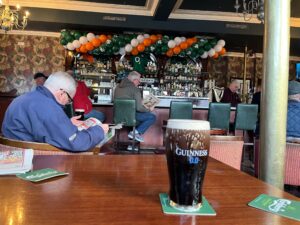 While it’s only a short walk from more ‘hipster’ bars like
While it’s only a short walk from more ‘hipster’ bars like 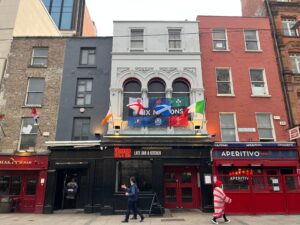 Back in the day – you know, perhaps 3 years ago – this week’s pub was The Porterhouse Central. It was a very handy spot in that you could enjoy a mix of interesting beers from Porterhouse and various guest options, but you avoided
Back in the day – you know, perhaps 3 years ago – this week’s pub was The Porterhouse Central. It was a very handy spot in that you could enjoy a mix of interesting beers from Porterhouse and various guest options, but you avoided 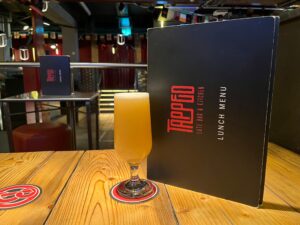 However, I happened to be in the area and had a bit of time after a meeting, so I gave Tapped another try. I’m pleased to say that the interior, while still feeling just slightly too ‘taproom’ has been softened and improved. There is now much more comfortable seating and the lighting is more dialled-in; it feels warmer on the whole. There are screens showing the beer lineup,
However, I happened to be in the area and had a bit of time after a meeting, so I gave Tapped another try. I’m pleased to say that the interior, while still feeling just slightly too ‘taproom’ has been softened and improved. There is now much more comfortable seating and the lighting is more dialled-in; it feels warmer on the whole. There are screens showing the beer lineup, 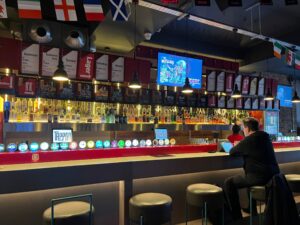
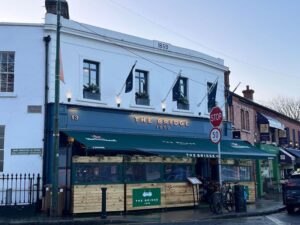 While it may seem that we rarely venture south of the Liffey (true, really), we recently had occasion to be down in our old Ballsbridge stomping grounds, and so returned to
While it may seem that we rarely venture south of the Liffey (true, really), we recently had occasion to be down in our old Ballsbridge stomping grounds, and so returned to 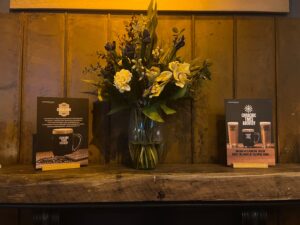 There has been much local discussion surrounding the launch of
There has been much local discussion surrounding the launch of  And that may be all well and good for many customers, but these new brews haven’t (mostly) muscled out the usual macro suspects; it’s the ‘good’ beers that have been jettisoned to make space, including – really a loss here – the Pilsner Urquell. Removed from The Bridge’s menu now are Rye River Upstream Pale Ale, Warsteiner lager and, er, Madri. The Madri may be no great loss, but the others are keenly felt (especially if, say, A Friend were really looking forward to a Pilsner Urquell, sighed to make do with a Warsteiner and then realised that the only drinkable lager was Carlsberg). To add insult to injury, the hand-painted panel all about Pilsner Urquell has been partially, but not entirely, covered by a television. Ouch.
And that may be all well and good for many customers, but these new brews haven’t (mostly) muscled out the usual macro suspects; it’s the ‘good’ beers that have been jettisoned to make space, including – really a loss here – the Pilsner Urquell. Removed from The Bridge’s menu now are Rye River Upstream Pale Ale, Warsteiner lager and, er, Madri. The Madri may be no great loss, but the others are keenly felt (especially if, say, A Friend were really looking forward to a Pilsner Urquell, sighed to make do with a Warsteiner and then realised that the only drinkable lager was Carlsberg). To add insult to injury, the hand-painted panel all about Pilsner Urquell has been partially, but not entirely, covered by a television. Ouch.
 This week’s pub is one that we’ve both been asked to profile repeatedly, and, in nearly equal measure, begged not to reveal it as a secret hidden gem. Is it possible to satisfy both of these audiences? Let’s find out – and so, we venture back to Marlborough Street, home to
This week’s pub is one that we’ve both been asked to profile repeatedly, and, in nearly equal measure, begged not to reveal it as a secret hidden gem. Is it possible to satisfy both of these audiences? Let’s find out – and so, we venture back to Marlborough Street, home to  Also unlike many other Old Man Pubs, there was an independent beer option: Kinnegar’s Scraggy Bay. In some pubs that don’t have that kind of turnover for non-Guinness options, they aren’t always as fresh, but there were no such issues here. Guinness was, of course, plentiful, but there were many pints of lager being consumed, too – it is slightly unusual to see Tuborg on one of the taps in a Dublin pub, but I have a soft spot for many Carlsberg products, so it was quite welcome. The décor is, again, by no means fancy, but it’s very well-kept: red and cream paint, lighter wood tones and simple brass lamps on the bar. The crowd was clearly mostly regulars, and although most were deeply invested in the multiple channels of horse racing, there were other long-running conversations, too.
Also unlike many other Old Man Pubs, there was an independent beer option: Kinnegar’s Scraggy Bay. In some pubs that don’t have that kind of turnover for non-Guinness options, they aren’t always as fresh, but there were no such issues here. Guinness was, of course, plentiful, but there were many pints of lager being consumed, too – it is slightly unusual to see Tuborg on one of the taps in a Dublin pub, but I have a soft spot for many Carlsberg products, so it was quite welcome. The décor is, again, by no means fancy, but it’s very well-kept: red and cream paint, lighter wood tones and simple brass lamps on the bar. The crowd was clearly mostly regulars, and although most were deeply invested in the multiple channels of horse racing, there were other long-running conversations, too.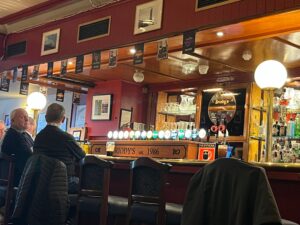 And while it may be true that this is not the cleanest nor most well-kept part of Dublin, that is presumably part of what keeps the tourists away, Georgian architecture notwithstanding. And although some parts of Reddit may be thoroughly convinced that we’re all just waiting to get murdered north of the Liffey, there are signs of positive development; newer pubs like The Morris Bar, just a short walk away, suggest that things are slowly improving. But for a pub like Briody’s that’s been here for over a century in various guises, it seems to be content to keep its current mix of regulars and semi-regulars who drop in whenever they are in town.
And while it may be true that this is not the cleanest nor most well-kept part of Dublin, that is presumably part of what keeps the tourists away, Georgian architecture notwithstanding. And although some parts of Reddit may be thoroughly convinced that we’re all just waiting to get murdered north of the Liffey, there are signs of positive development; newer pubs like The Morris Bar, just a short walk away, suggest that things are slowly improving. But for a pub like Briody’s that’s been here for over a century in various guises, it seems to be content to keep its current mix of regulars and semi-regulars who drop in whenever they are in town.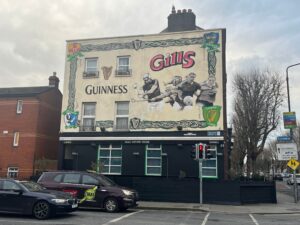 Although I’ve lived an extremely brief walk from James Gill’s Corner House for over 4 years, I have never managed to be going past when it was open – until now. Its ‘regular’ opening hours are nothing of the sort, but that’s part of this pub’s mythology. Gill’s Pub opens when Gill’s Pub decides to do so. So, what’s it like?
Although I’ve lived an extremely brief walk from James Gill’s Corner House for over 4 years, I have never managed to be going past when it was open – until now. Its ‘regular’ opening hours are nothing of the sort, but that’s part of this pub’s mythology. Gill’s Pub opens when Gill’s Pub decides to do so. So, what’s it like?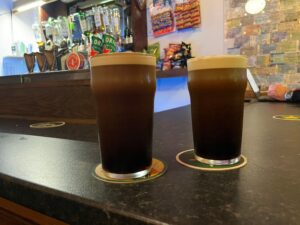 As mentioned, the opening hours are…erratic at best. But if the door is open, you’ll find the walls lined with match-day programs and event posters from previous games and concerts (for those of us who live nearby, we can simply hear everything in the garden – a blessing or a curse, depending on the fixture or artist). But inside there is also the mural of
As mentioned, the opening hours are…erratic at best. But if the door is open, you’ll find the walls lined with match-day programs and event posters from previous games and concerts (for those of us who live nearby, we can simply hear everything in the garden – a blessing or a curse, depending on the fixture or artist). But inside there is also the mural of 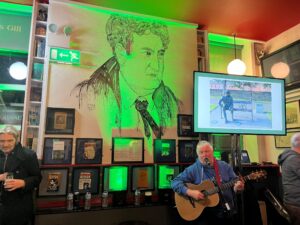 But during Behan’s youth, this area wasn’t merely residential –
But during Behan’s youth, this area wasn’t merely residential –  While our stats here show that you seem to be extremely interested in
While our stats here show that you seem to be extremely interested in  Of course, Walsh’s is far from new, as it’s been trading on this corner since 1826, so it’s coming up on two centuries in business. One wonders if there is to be an epic celebration next year…but back to the pub itself. It’s got a beautiful mix of stained glass and dark wood, cosy nooks and a fantastic snug…really, it’s quite close to the Platonic ideal of a late-19th century Dublin pub (albeit with televisions for the footy), so its recent restoration work has been well-planned and executed. The look and feel is certainly closer to the end of the 19th century than the beginning, but that’s no critique. And while it is best-known for its Guinness, they also serve Beamish, and there are also fresh lines of Trouble’s Ambush and Kinnegar’s Scraggy Bay – it made an ideal stopping-off point for my traditional
Of course, Walsh’s is far from new, as it’s been trading on this corner since 1826, so it’s coming up on two centuries in business. One wonders if there is to be an epic celebration next year…but back to the pub itself. It’s got a beautiful mix of stained glass and dark wood, cosy nooks and a fantastic snug…really, it’s quite close to the Platonic ideal of a late-19th century Dublin pub (albeit with televisions for the footy), so its recent restoration work has been well-planned and executed. The look and feel is certainly closer to the end of the 19th century than the beginning, but that’s no critique. And while it is best-known for its Guinness, they also serve Beamish, and there are also fresh lines of Trouble’s Ambush and Kinnegar’s Scraggy Bay – it made an ideal stopping-off point for my traditional 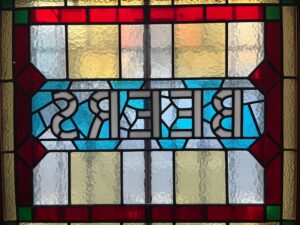 And Walsh’s has another point or two in its favour: it has the full-on Victorian pub splendour, without the crush of tourists you can get at The Long Hall, and it has more variety on offer, drinks-wise, than
And Walsh’s has another point or two in its favour: it has the full-on Victorian pub splendour, without the crush of tourists you can get at The Long Hall, and it has more variety on offer, drinks-wise, than 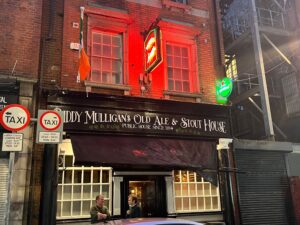 Edit again, mid-April 2025: Welcome to
Edit again, mid-April 2025: Welcome to  We’ll come back to his point about the people later, but at first glance, I had the same reaction – why on earth had what looked like an Oirsh pub been dropped into the centre of Dublin? While it’s true that there are Dublin pubs that cater more to the tourist trade than to locals (and not just in Temple Bar) that do dip into a more stereotypical ‘Irish pub’ feel, to tip over into what we might call Full Oirish seemed, well, unseemly. Unnecessary. Just a bit, well, naff.
We’ll come back to his point about the people later, but at first glance, I had the same reaction – why on earth had what looked like an Oirsh pub been dropped into the centre of Dublin? While it’s true that there are Dublin pubs that cater more to the tourist trade than to locals (and not just in Temple Bar) that do dip into a more stereotypical ‘Irish pub’ feel, to tip over into what we might call Full Oirish seemed, well, unseemly. Unnecessary. Just a bit, well, naff. While it’s still a small spot, the dark wood and low lighting add to the cosy feel, and the interior décor is very much ‘Easter Rising’ themed with images of the leaders around the pub, it doesn’t veer off into a theme park feel; indeed, given that the pub is steps away from the GPO, if the interior matched the exterior sign, it could easily career rapidly into the realm of the offensive. But – and here’s the thing – it does not! It’s quite nice! It includes portraits of many of the women involved – something especially notable if, like me, you’ve recently watched ‘Michael Collins’ for the first and only time, and wondered where the women were…but I digress.
While it’s still a small spot, the dark wood and low lighting add to the cosy feel, and the interior décor is very much ‘Easter Rising’ themed with images of the leaders around the pub, it doesn’t veer off into a theme park feel; indeed, given that the pub is steps away from the GPO, if the interior matched the exterior sign, it could easily career rapidly into the realm of the offensive. But – and here’s the thing – it does not! It’s quite nice! It includes portraits of many of the women involved – something especially notable if, like me, you’ve recently watched ‘Michael Collins’ for the first and only time, and wondered where the women were…but I digress. Sometimes, just sometimes, a fantastic new(ish) pub pops up where you least expect it. Dublin’s Talbot Street has had a lot of publicity
Sometimes, just sometimes, a fantastic new(ish) pub pops up where you least expect it. Dublin’s Talbot Street has had a lot of publicity  At that time, the shopfront that is now the pub was The Morris Wallpaper Stores, and the signage from that era has been preserved above the door. The theme continues inside, with framed William Morris wallpaper samples on the exposed brick, giving a mix of industrial chic and cosy early-20th century-pub vibes. There’s a pizza spot toward the back (check for opening hours, as these things evolve) with more communal-styles tables, but the seating in the main bar is much ‘pubbier,’ and very comfortable indeed.
At that time, the shopfront that is now the pub was The Morris Wallpaper Stores, and the signage from that era has been preserved above the door. The theme continues inside, with framed William Morris wallpaper samples on the exposed brick, giving a mix of industrial chic and cosy early-20th century-pub vibes. There’s a pizza spot toward the back (check for opening hours, as these things evolve) with more communal-styles tables, but the seating in the main bar is much ‘pubbier,’ and very comfortable indeed.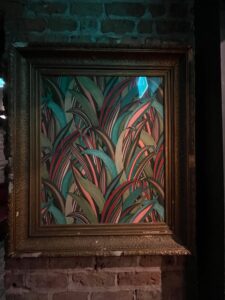 There’s a good mix of the usual Guinness-and-friends offerings, but also a handy Rye River tap, as well as Beamish for the Corkonians in your life. The cocktail list is interesting as well. On our visit, the staff were all wonderful, and the attention to detail that went into the design of the pub is evident. It hits just the right mark of honouring the building’s past without feeling like a theme pub.
There’s a good mix of the usual Guinness-and-friends offerings, but also a handy Rye River tap, as well as Beamish for the Corkonians in your life. The cocktail list is interesting as well. On our visit, the staff were all wonderful, and the attention to detail that went into the design of the pub is evident. It hits just the right mark of honouring the building’s past without feeling like a theme pub.
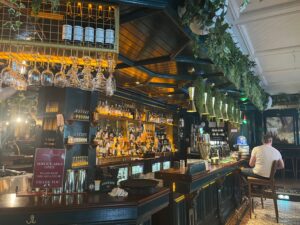 While it was likely something akin to a coaching inn in that earlier phase – again, like its not-too-distant neighbour in Drumcondra – having a tourist site spring up nearby in the form of the National Botanic Gardens in the 19th century was a boon to business, similar to the relationship between the nearby
While it was likely something akin to a coaching inn in that earlier phase – again, like its not-too-distant neighbour in Drumcondra – having a tourist site spring up nearby in the form of the National Botanic Gardens in the 19th century was a boon to business, similar to the relationship between the nearby 